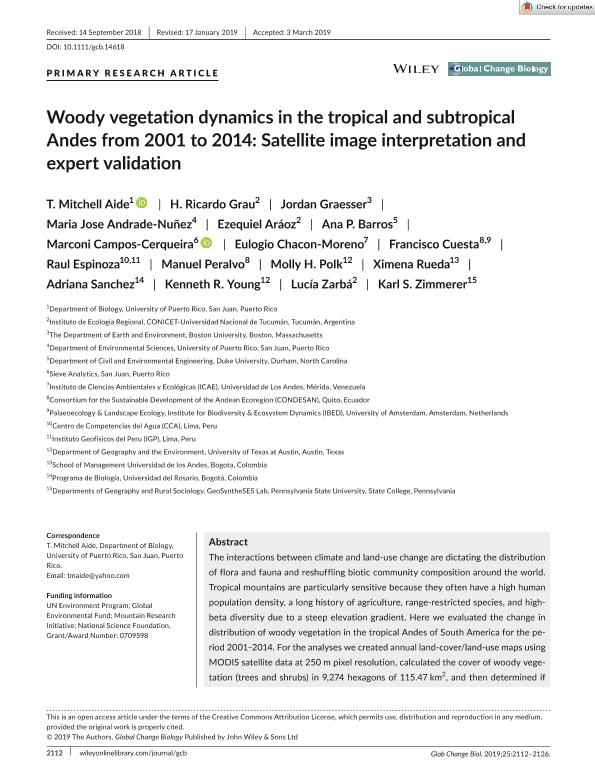Artículo
Woody vegetation dynamics in the tropical and subtropical Andes from 2001 to 2014: Satellite image interpretation and expert validation
Aide, T. Mitchell; Grau, Hector Ricardo ; Graesser, Jordan; Andrade Nuñez, Maria Jose; Aráoz, Ezequiel
; Graesser, Jordan; Andrade Nuñez, Maria Jose; Aráoz, Ezequiel ; Barros, Ana; Campos Cerqueira, Marconi; Chacon-Moreno, Eulogio; Cuesta, Francisco; Espinoza, Raúl; Peralvo, Manuel; Polk, Molly H.; Rueda, Ximena; Sanchez, Adriana; Young, Kenneth R.; Zarbá, Lucía
; Barros, Ana; Campos Cerqueira, Marconi; Chacon-Moreno, Eulogio; Cuesta, Francisco; Espinoza, Raúl; Peralvo, Manuel; Polk, Molly H.; Rueda, Ximena; Sanchez, Adriana; Young, Kenneth R.; Zarbá, Lucía ; Zimmerer, Karl S.
; Zimmerer, Karl S.
 ; Graesser, Jordan; Andrade Nuñez, Maria Jose; Aráoz, Ezequiel
; Graesser, Jordan; Andrade Nuñez, Maria Jose; Aráoz, Ezequiel ; Barros, Ana; Campos Cerqueira, Marconi; Chacon-Moreno, Eulogio; Cuesta, Francisco; Espinoza, Raúl; Peralvo, Manuel; Polk, Molly H.; Rueda, Ximena; Sanchez, Adriana; Young, Kenneth R.; Zarbá, Lucía
; Barros, Ana; Campos Cerqueira, Marconi; Chacon-Moreno, Eulogio; Cuesta, Francisco; Espinoza, Raúl; Peralvo, Manuel; Polk, Molly H.; Rueda, Ximena; Sanchez, Adriana; Young, Kenneth R.; Zarbá, Lucía ; Zimmerer, Karl S.
; Zimmerer, Karl S.
Fecha de publicación:
06/2019
Editorial:
Wiley Blackwell Publishing, Inc
Revista:
Global Change Biology
ISSN:
1354-1013
e-ISSN:
1365-2486
Idioma:
Inglés
Tipo de recurso:
Artículo publicado
Clasificación temática:
Resumen
The interactions between climate and land-use change are dictating the distribution of flora and fauna and reshuffling biotic community composition around the world. Tropical mountains are particularly sensitive because they often have a high human population density, a long history of agriculture, range-restricted species, and high-beta diversity due to a steep elevation gradient. Here we evaluated the change in distribution of woody vegetation in the tropical Andes of South America for the period 2001–2014. For the analyses we created annual land-cover/land-use maps using MODIS satellite data at 250 m pixel resolution, calculated the cover of woody vegetation (trees and shrubs) in 9,274 hexagons of 115.47 km 2 , and then determined if there was a statistically significant (p < 0.05) 14 year linear trend (positive—forest gain, negative—forest loss) within each hexagon. Of the 1,308 hexagons with significant trends, 36.6% (n = 479) lost forests and 63.4% (n = 829) gained forests. We estimated an overall net gain of ~500,000 ha in woody vegetation. Forest loss dominated the 1,000–1,499 m elevation zone and forest gain dominated above 1,500 m. The most important transitions were forest loss at lower elevations for pastures and croplands, forest gain in abandoned pastures and cropland in mid-elevation areas, and shrub encroachment into highland grasslands. Expert validation confirmed the observed trends, but some areas of apparent forest gain were associated with new shade coffee, pine, or eucalypt plantations. In addition, after controlling for elevation and country, forest gain was associated with a decline in the rural population. Although we document an overall gain in forest cover, the recent reversal of forest gains in Colombia demonstrates that these coupled natural-human systems are highly dynamic and there is an urgent need of a regional real-time land-use, biodiversity, and ecosystem services monitoring network.
Archivos asociados
Licencia
Identificadores
Colecciones
Articulos(IER)
Articulos de INSTITUTO DE ECOLOGIA REGIONAL
Articulos de INSTITUTO DE ECOLOGIA REGIONAL
Citación
Aide, T. Mitchell; Grau, Hector Ricardo; Graesser, Jordan; Andrade Nuñez, Maria Jose; Aráoz, Ezequiel; et al.; Woody vegetation dynamics in the tropical and subtropical Andes from 2001 to 2014: Satellite image interpretation and expert validation; Wiley Blackwell Publishing, Inc; Global Change Biology; 25; 6; 6-2019; 2112-2126
Compartir
Altmétricas



